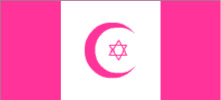 My pictures from 1999 to 2000 are reflections from a trip through the Middle East. They show Central Europeans the world of contemporary Islam through the ideas inspired in them by Stories from the Thousand and One Nights. This book is interesting, because since our childhood it (as one of few) has given us information about the world of the distant Orient. I am pretty sure that few Czechs have read the Koran or any other significant Arabic literature. Stories from the Thousand and One Nights brings out in us the illusion of fairy-tale mystery and exoticism, which, according to my experiences, extremely contrast with reality and with how western information media convey it. Another thing that’s interesting to me in connection with the series of images called Bin Laden’s Lamp are the extraordinary inclinations of some followers of Islam towards extremist activity. How does extremism fuse with the Paradise that is the goal of the spiritual path of believers? I am inclined to understand Paradise as something harmonious and universal. The paradox of the Islamic path interests me, allowing people to enter it through violence, murder and suicide, which are very extreme acts. The fall of the iron curtain in connection with globalization now allows the integration of the Orient into our living space – and this fact changes our naive ideas about it. Instead of trying to understand it, we protect ourselves, because it brings up in us uncertainty and fear, which sometimes leads to our own extreme positions. The pictures are made in such a way that, seen from a distance, they should create the feeling of something universal, abstract and pleasant. They want to encourage interest so that the viewer approaches the details inside the ornaments, where little characters inspired by illustrations from several classic Islamic literary works from the 19th century can be found. These books were made at a time when European travelers made their way more and more into the Orient. Several of them had the chance to reside in the courtyards of important Shah’s and these books were consequently passed along to European culture and art. This experience also influenced the visual quality of the illustrations – the imported elements of figuration. Thus, the little illustrations came mostly from the influences of the European Renaissance and romantic painting, which intended to express the ideal of Islamic beauty. In my version, however, something is not altogether right with them, because they behave “contemporarily,” tendentiously, sometimes stupidly or improperly and to the extreme, which causes in the given environment controversial tension. Extreme behavior need not always display itself where the viewer might expect, far more often it is the opposite. You see, it is possible to perform extreme actions that are very inconspicuous and unimportant – tying your shoelaces, bouncing a ball on a beach, pouring milk into a cup….
My pictures from 1999 to 2000 are reflections from a trip through the Middle East. They show Central Europeans the world of contemporary Islam through the ideas inspired in them by Stories from the Thousand and One Nights. This book is interesting, because since our childhood it (as one of few) has given us information about the world of the distant Orient. I am pretty sure that few Czechs have read the Koran or any other significant Arabic literature. Stories from the Thousand and One Nights brings out in us the illusion of fairy-tale mystery and exoticism, which, according to my experiences, extremely contrast with reality and with how western information media convey it. Another thing that’s interesting to me in connection with the series of images called Bin Laden’s Lamp are the extraordinary inclinations of some followers of Islam towards extremist activity. How does extremism fuse with the Paradise that is the goal of the spiritual path of believers? I am inclined to understand Paradise as something harmonious and universal. The paradox of the Islamic path interests me, allowing people to enter it through violence, murder and suicide, which are very extreme acts. The fall of the iron curtain in connection with globalization now allows the integration of the Orient into our living space – and this fact changes our naive ideas about it. Instead of trying to understand it, we protect ourselves, because it brings up in us uncertainty and fear, which sometimes leads to our own extreme positions. The pictures are made in such a way that, seen from a distance, they should create the feeling of something universal, abstract and pleasant. They want to encourage interest so that the viewer approaches the details inside the ornaments, where little characters inspired by illustrations from several classic Islamic literary works from the 19th century can be found. These books were made at a time when European travelers made their way more and more into the Orient. Several of them had the chance to reside in the courtyards of important Shah’s and these books were consequently passed along to European culture and art. This experience also influenced the visual quality of the illustrations – the imported elements of figuration. Thus, the little illustrations came mostly from the influences of the European Renaissance and romantic painting, which intended to express the ideal of Islamic beauty. In my version, however, something is not altogether right with them, because they behave “contemporarily,” tendentiously, sometimes stupidly or improperly and to the extreme, which causes in the given environment controversial tension. Extreme behavior need not always display itself where the viewer might expect, far more often it is the opposite. You see, it is possible to perform extreme actions that are very inconspicuous and unimportant – tying your shoelaces, bouncing a ball on a beach, pouring milk into a cup….
